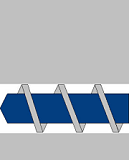DuPont Shanghai: Battenfeld Gloucester 3- and 9-Coextrusion Film Lines
Thursday, May 25th, 2006Two coextrusion lines, including one with nine-layer capability, will enhance market-development efforts of DuPont in multilayer and barrier films at the new laboratory in Shanghai.
DuPont Packaging & Industrial Polymers has ordered two blown film extrusion lines from Battenfeld Gloucester Engineering Co., Inc. for installation in its new R&D Laboratory in Shanghai, which is located in the DuPont China Re-search and Development Center that opened last year. The blown film lines will be used by DuPont and customers throughout the world to develop multilayer and barrier films for the growing market for the packaging of food and con-sumer products, industrial films and other applications.
The equipment includes a three-layer line that will be used primarily for smaller scale development work, and a nine-layer line for production scale-up that includes com-ponents specified by DuPont to enhance process capabilities and barrier properties. Installation of the three-layer line is scheduled for the summer, while the nine-layer line will be set up in the fall.
Pascal Rechatin, Managing Director Asia Pacific, DuPont Packaging & Industrial Polymers said at the opening, ‘Our business has laboratories and R&D facilities in different countries and regions globally such as the United States, Canada, Europe and Japan. The new R&D facility in China is the latest member joining our worldwide customer development and support network. The facilities all collaborate with one another to help increase competitiveness of our customers. This will help to enhance existing products, and bring new products to market more quickly, efficiently and cost effectively.’
‘Blown film coextrusion is an important market for the barrier resins and specialty ethylene copolymers that DuPont offers globally,’ says Roger Kant, Asia-Pacific Business Development and Technical Manager for DuPont Packaging & Industrial Polymers. ‘The decision to invest in the nine-layer line is based on our confidence in the industry’s potential for expansion. The line will support our business globally. In-stalling the line in China will also enable us to work more closely with customers there, in the Asia-Pacific region and globally.’
Bill Joyce, Battenfeld Gloucester’s Director of International Business Asia/Pacific Region, says the blown film lines represent a collaborative effort by DuPont and Bat-tenfeld Gloucester to develop the market for barrier packaging in China. ‘The high barrier film packaging market in China continues to grow at a very rapid pace,’ he notes ‘with unlimited growth potential.’
DuPont Packaging & Industrial Polymers plans to use the equipment to work with its customers to develop multilayer and barrier structures based on its own grades of ethylene copolymers and polyamides, as well as LDPE, LLDPE, metallocene PE, polypropylene, EVA, EVOH, PET, ionomers, liquid crystal polymers and tie layer res-ins.
‘We expect to work with customers in diverse and interesting applications,’ Kant says. ‘These include barrier and nonbarrier films for fresh and processed meats, seafood packaging, lidding structures, personal care products, healthcare products, and films for industrial and electronic markets. The nine-layer line will allow us to simulate structures and process conditions from simple monolayer films to complex barrier films.’
The nine-layer line will be one of the most advanced in China, says Bill Hellmuth, Senior Product Manager for Blown Film at Battenfeld Gloucester. ‘There are very few nine-layer lines running anywhere.’ The line can extrude nine-layer films in gauges of 30 to 250 microns, with a maximum lay-flat width of 1270 mm (50 inches).
Features of the line include gravimetric feeding and blending; nine smooth-bore Con-tracool® extruders with 50 mm diameter barrels and 30 L/D screws; an Extrol™ 6032 microprocessor control system with Extrol Windows-based Pro PC graphic in-terface and Extrol Anywhere, a modem for remote diagnostics; an online beta thick-ness gauge from NDC Infrared Engineering; a horizontal oscillating haul-off with composite roller collapsers; Enercon corona treaters; and two model 1011S, single-turret, center-gap winders with splitting nips.
Among the options on the line is a nine-layer Optiflow™ die, with dual-lip air ring and internal bubble cooling, that can be configured as a 200 mm or 300 mm (8- or 12-inch) diameter die by changing inserts. This will permit DuPont to achieve a wide angle of blow-up ratios and throughput rates.
Another option is a water-cooling system for the primary nip rolls. The chrome nip roll is internally cooled by water; the rubber nip roll is surface-cooled by a separate steel rider roll with an internal water chamber. The rider roll draws heat from the surface of the rubber nip roll. The benefit, Hellmuth says, is that the physical properties and curl of multilayer films are better controlled by maintaining an even temperature on the nip rolls.
The nine-layer line also features a powered splitting station that separates both halves of the bubble to feed separate treaters and winders. Hellmuth says this is an important capability for tacky films, which can require a lot of tension to separate them. The powered splitting station assures a clean separation of webs for subse-quent winding at lower tension. The system includes a post-treat cooling roll to re-duce film temperature prior to winding.
The three-layer pilot line is more basic in design but capable of meeting all research and development needs. Equipment includes: three smooth-bore Contracool extrud-ers with 30 mm barrels and 30 L/D screws; a three-layer, 75 mm diameter Optiflow die with dual-lip air ring; a primary nip assembly with composite roller collapsers; dual-spindle shaftless winder; and an Extrol 6016 microprocessor control system.
The line can extrude film in gauges of 35 to 135 microns, and achieves a maximum lay-flat width of 350 mm (14 inches).
The initial results of development work on both lines could be available later this year. ‘The combination of the expertise of DuPont in packaging and industrial resins and Battenfeld Gloucester’s experience in designing advanced extrusion equipment will create tremendous opportunities for film makers and converters in China, the Asia Pacific region and global customers, while adding to their knowledge world-wide.’
